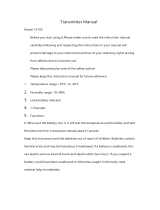
2. Turn on Bluetooth manually to connect device to smartphone.
3. Find the name and the unique MAC ID of blood pressure monitor in the pairing list
displayed on your phone, check if MAC ID displayed on the monitor and on the
phone are matching; if the name and MAC ID information are correct, select to
proceed with the pairing, then Bluetooth® icon showed without blinking. If the name
and MAC ID shown on the phone is not the same as displayed on the monitor,
please abort the connection and make sure the correct monitor and phone are
used.
4. For 1st pairing, both phone and monitor will show 6 digits “Passkey” before pairing.
Make sure the numbers are the same between phone & monitor to avoid
misconnection to wrong BT device. It will be paired automatically without Passkey
from next connection. If the “Passkey” on the monitor and on the phone are not the
same, the monitor maybe connected to an incorrect phone, and the pairing should
be aborted.
5. After pairing, the App will show message to setup device user selection (1 or 2) to
the App user profile. Confirm to proceed with setup. Cancel to abort setup (if user
selection is incorrect).
6. After setup, the device will automatically exchange measurement data and
date/time settings with the app. Bluetooth turns off automatically after data exchange.
Bluetooth status:
- Bluetooth symbol 15 blinking slowly: Bluetooth is activated and waiting for
connection.
- Bluetooth symbol 15 not blinking: Bluetooth connection established.
- Bluetooth symbol 15 blinking rapidly: Bluetooth connection error.
In case of Bluetooth connection error, turn off device Bluetooth, wait for a minute,
then re-try Bluetooth connection. Refer to Chapter 7 for details.
Wireless communication interference
This product operates in an unlicensed ISM band at 2.4 GHz. In the event this product
is used near other wireless devices such as microwave and wireless LAN, which
operate on the same frequency band as this product, there is a possibility that
interference may occur. If interference occurs, stop the operation of the other devices
or relocate this product away from other wireless devices before attempting to use it.
9. PC-Link Functions
This device can be used in conjunction with a personal computer (PC) running the
Microlife Blood Pressure Analyser (BPA+) software. The memory data can be
transferred to the PC by connecting the monitor via a cable.
If no download-voucher and cable is included download the BPA software from
www.microlife.com/technologies/connect/bpaplus and use a Micro-USB cable.





















